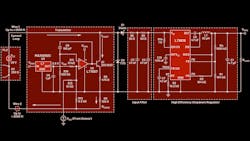Buck Regulators Quench Current-Loop Transmitter’s Power Thirst (Download)
Autonomous control is increasingly prevalent in industrial and consumer applications, but even cutting-edge autonomy solutions rely on an old technique—the current loop. Current loops are a ubiquitous component in control loops that work both directions. They convey measurements from sensors to programmable logic controllers (PLCs) and conversely convey control outputs from the PLC to process modulation devices.
The 4- to 20-mA current loop is the dominant industry standard for accurate and reliable transmission of data via a twisted-pair cable from remote sensors to a PLC. Simplicity, longevity, robustness, proven reliable data transfer over long distances, good noise immunity, and low implementation cost suit this interface for long-term industrial process control and automated monitoring of remote objects in noisy environments.
